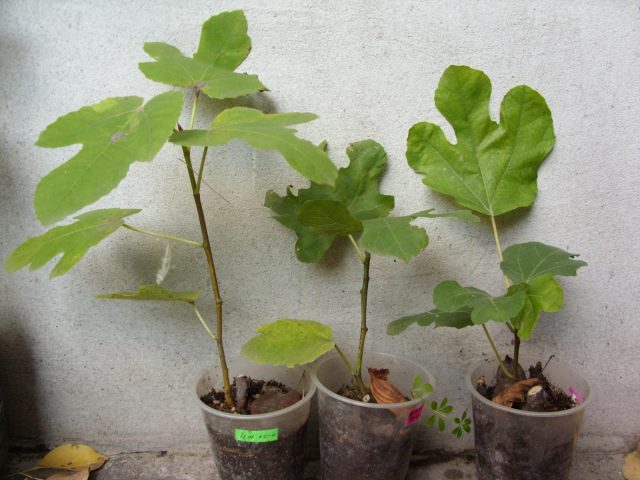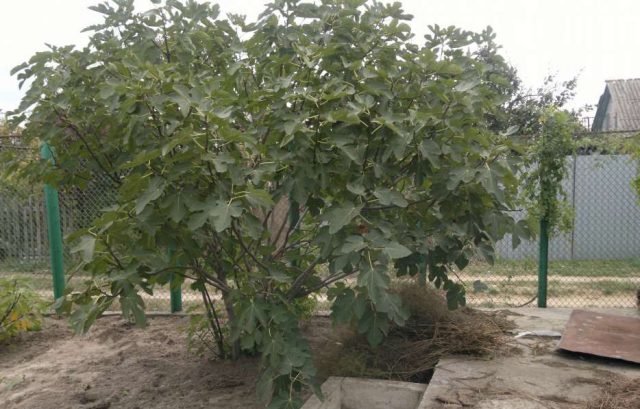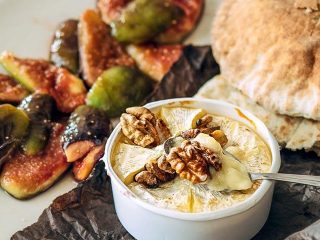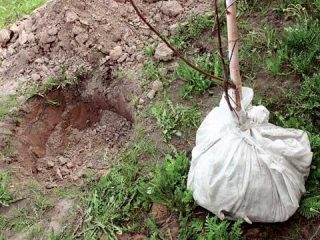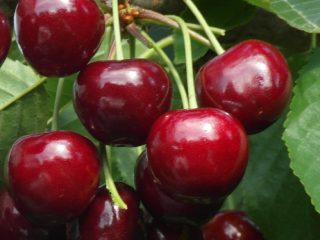Content
Brunswick figs have been known for a long time. One of the most frost-resistant varieties spread throughout the southern regions of the country among gardening enthusiasts. Enthusiasts also grow figs in the middle zone, providing a reliable special shelter or transferring them to a large tub that stands in a frost-free room.
Description of Brunswick figs
In the subtropics, the tree grows over 2 m, the flat-rounded crown is created by spreading branches. The roots of figs are just as branched, sometimes more than 10 m in diameter and 5-7 m deep. In the Russian climate, even in the south, Brunswick figs are not allowed to reach such a height by regularly pruning the branches, and when planting, care is taken to prevent the long spread of roots. The leaves are sharply different from any known crop: very large, up to 20-25 cm, with deeply cut lobes. Dense and rough on top, fleecy and soft below. Flowers of the female type are also unusual, inconspicuous, located inside the future fruit formation, which grows in the form of an irregular, elongated ball.
Early self-fertile Brunswick fig gives 2 full harvests if there is sufficient heat:
- in midsummer;
- at the beginning of autumn.
The Brunswick variety ripens within 2.5-3 months. The fruits reach technical ripeness 25-60 days after harvest.
In mid-summer, the first wave of ripe Brunswick figs is quite sparse. The fruits are large, with a flat top, measuring 5x7 cm, weighing up to 100 g or more. The outer skin color is often purple. There is a large cavity in the pink juicy pulp. The taste is sweet and pleasant. Autumn fig fruits are irregularly pear-shaped, small - 5x4 cm, do not exceed 70 g, and may not ripen in the middle zone climate due to early frosts. The thin, fleecy skin is light green and turns yellow-brown in the sun. The fruits of the second harvest have tender, reddish-brown flesh with a high sugar content and a small cavity. The seeds are small and common.
Frost resistance of Brunswick figs
According to the description, when grown in open ground, Brunswick figs can withstand frosts down to -27 °C when covered. However, in reviews, many gardeners indicate that prolonged low temperatures below - 20 ° C lead to freezing of the plant. The Brunswick variety has the ability to recover after a harsh winter and send out new shoots from the root system preserved under shelter. The main task of the gardener is to keep the roots from freezing. This is achieved by specific methods of shelter. The crop is grown in greenhouses or indoor conditions, planted in tubs in those zones of frost resistance of plants where the maximum minus values fall below the level of 18-12 ° C.
Pros and cons of the Brunswick fig variety
The fruits of this southern crop are so excellent in taste that gardeners dream of new breeding achievements. Perhaps somewhere they are already working on developing more frost-resistant varieties of figs. For most gardeners in the middle zone, the impossibility of wintering the plant in open ground is the only drawback of the Brunswick variety. Although it is still the most cold-resistant of its species.
Advantages of the Brunswick variety:
- figs are adapted for growing in climates where in winter subzero temperatures briefly drop to -20 °C;
- high productivity;
- excellent taste;
- self-fertility;
- early ripeness;
- possibility of collecting sweet fruits twice a day.
Growing Brunswick Figs
Remontant Brunswick figs with light green fruits are planted taking into account the specific requirements for caring for the southern crop.
Selection and preparation of a landing site
Figs are unpretentious to soils: they can grow well on sandy, loamy, clayey and calcareous soils. But the taste of the fruit depends on the amount of minerals in the planting hole and on the site. High acidity of the soil is not suitable for the crop. One of the important requirements for successfully growing figs is a sufficient amount of moisture and at the same time good drainage of the soil. In the middle zone, for the Brunswick variety, it is better to dig a trench in advance along with a hole where the plant is placed for winter shelter.For the planting substrate, garden soil is mixed with an equal part of humus or compost and half of the sand is added. The landing site should only be on the south side, protected by buildings on the north.
Perlite is added to the substrate in the tubs, and a drainage layer is also provided. Indoor plants of the variety are replanted after 2-3 years, constantly cutting off the roots during transfer.
Landing rules
When planting the Brunswick variety, the following requirements are met:
- the planting pit should be 2 times the volume of the container from the nursery;
- when planting figs, the stem is placed deeper in the soil than it grew in the container;
- near the trunk, retreating 20-30 cm, hammer in a support;
- straighten the roots, sprinkle with the remaining substrate, simultaneously compacting it several times;
- water with 10 liters of water, every other day moisten it again with this amount and mulch the hole.
Watering and fertilizing
Brunswick figs are irrigated moderately, taking into account the age of the plant:
- in the first 2-3 years, water every 7 days, a bucket per tree;
- adult specimens - once every 2 weeks, 10-12 liters;
- During the fruit ripeness phase, watering is not carried out;
- The last watering is applied after harvesting the fruits in September.
The culture is fed after 15 days:
- Nitrogen preparations are used in spring;
- during flowering - complex, with phosphorus;
- Potassium compounds are added in the phase of enlargement of the ovaries.
It is convenient to carry out foliar feeding with ready-made balanced products. A good fertilizer for figs is organic matter. A prerequisite for fertilizing is application with watering for better absorption of nutrients.
Trimming
Brunswick figs, judging by the description of the variety and photos, in the southern regions form a spreading cup-shaped crown, with a stem height of 40-60 cm. In the middle zone there is a two-meter bush, which is easier to bend to the ground for shelter in winter. In spring, shoots that thicken the crown are removed. Fan pruning is also practiced, when all the branches that grow vertically are cut off from a three-year-old seedling. The lower shoots are bent using available means after the tree has been watered. Branches older than 5 years are cut off at ground level in the fall, because they no longer bend over when covering. New shoots of the Brunswick variety begin to bear fruit within a year.
Preparing for winter
In the gardens of the middle climate zone, the vines of the Brunswick fig, formed by a bush, are bent down and dug into pre-prepared trenches. The branches are bent gradually, starting from the day the last fruits are removed. In regions with mild winters, the entire tree is wrapped after the onset of frost. The tree trunk circle is mulched with sawdust, peat or spruce branches. In Crimea, the Brunswick variety is grown without winter shelter.
Harvesting
For figs of this variety, the fruits first ripen in the first ten days of July, the second harvest in September. Autumn fruiting lasts about a month. The ripe fruits are removed, then the green ones for ripening. Used fresh, for preservation and drying.
Diseases and pests
Figs are threatened by the fungal disease fusarium, which first affects the roots and lower part of the trunk. Then the plant dies. Affected specimens are removed from the area. The crop is parasitized by aphids, moths, and psyllids, which destroy leaves, damage fruits, and transmit pathogens of fungal and viral diseases.The proliferation of pests and the spread of diseases is prevented by autumn harvesting of leaves and spraying of the buds with copper-containing preparations, treatment with fungicides, and insecticides.
Reviews of Brunswick figs
Conclusion
Brunswick figs, the most frost-resistant variety of the species, are cultivated by many keen gardeners. Before purchasing a seedling, carefully study the specifics of growing exotic plants. Creating suitable conditions will make it possible to enjoy the legendary fruits.


